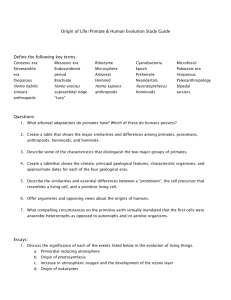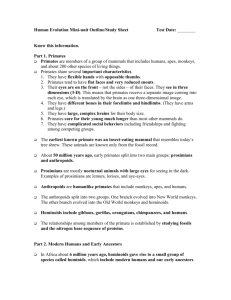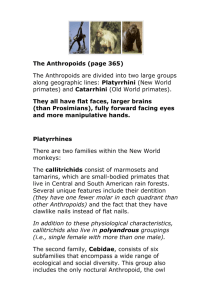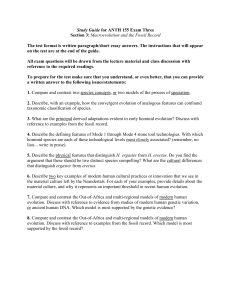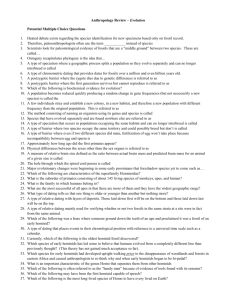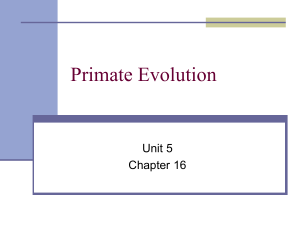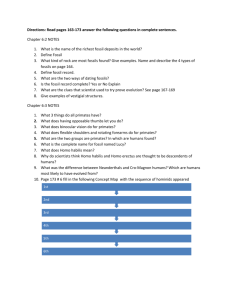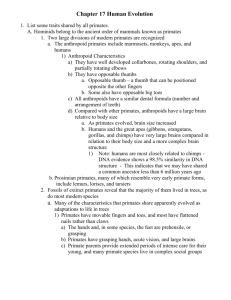Chapter 17 Human Evolution
advertisement
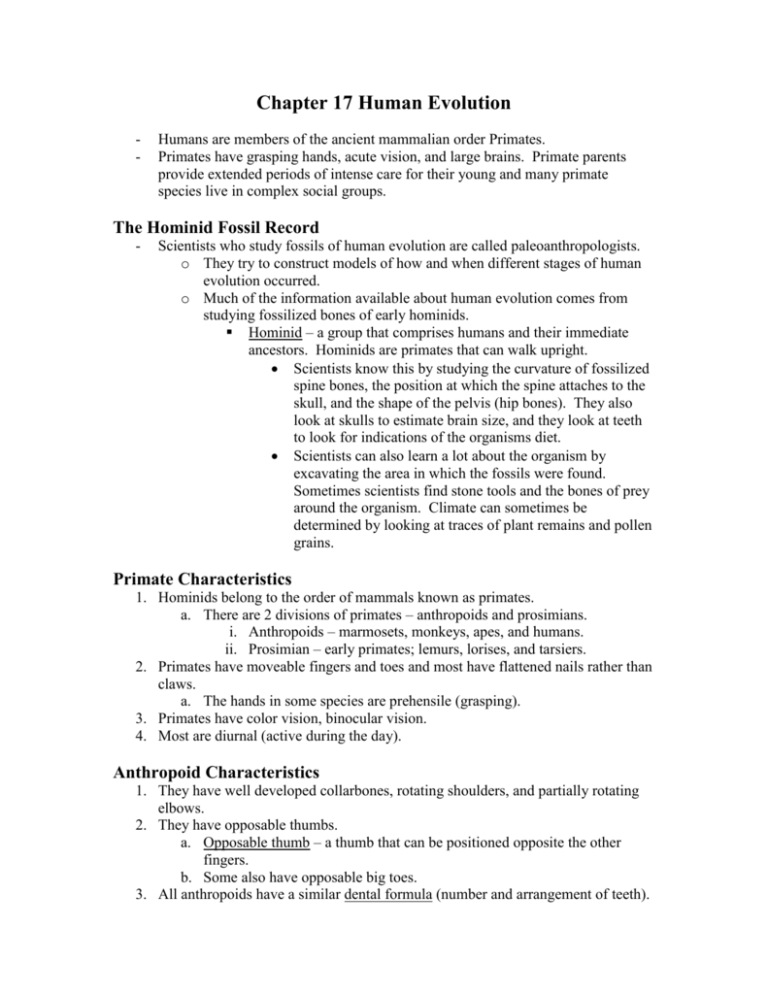
Chapter 17 Human Evolution - Humans are members of the ancient mammalian order Primates. Primates have grasping hands, acute vision, and large brains. Primate parents provide extended periods of intense care for their young and many primate species live in complex social groups. The Hominid Fossil Record - Scientists who study fossils of human evolution are called paleoanthropologists. o They try to construct models of how and when different stages of human evolution occurred. o Much of the information available about human evolution comes from studying fossilized bones of early hominids. Hominid – a group that comprises humans and their immediate ancestors. Hominids are primates that can walk upright. Scientists know this by studying the curvature of fossilized spine bones, the position at which the spine attaches to the skull, and the shape of the pelvis (hip bones). They also look at skulls to estimate brain size, and they look at teeth to look for indications of the organisms diet. Scientists can also learn a lot about the organism by excavating the area in which the fossils were found. Sometimes scientists find stone tools and the bones of prey around the organism. Climate can sometimes be determined by looking at traces of plant remains and pollen grains. Primate Characteristics 1. Hominids belong to the order of mammals known as primates. a. There are 2 divisions of primates – anthropoids and prosimians. i. Anthropoids – marmosets, monkeys, apes, and humans. ii. Prosimian – early primates; lemurs, lorises, and tarsiers. 2. Primates have moveable fingers and toes and most have flattened nails rather than claws. a. The hands in some species are prehensile (grasping). 3. Primates have color vision, binocular vision. 4. Most are diurnal (active during the day). Anthropoid Characteristics 1. They have well developed collarbones, rotating shoulders, and partially rotating elbows. 2. They have opposable thumbs. a. Opposable thumb – a thumb that can be positioned opposite the other fingers. b. Some also have opposable big toes. 3. All anthropoids have a similar dental formula (number and arrangement of teeth). 4. Compared with other primates, anthropoids have a large brain relative to body size. a. As primates evolved, brain size increased. b. Humans and the great apes (gibbons, orangutans, gorillas, and chimps) have very large brains compared in relation to their body size and a more complex brain structure. Note: humans are most closely related to chimps. DNA evidence shows a 98.5% similarity in DNA structure. This indicates that we may have shared a common ancestor less than 6 million years ago. Characteristics of Humans 1. Bipedalism – the ability to walk upright. a. Humans have an “S” shaped spine whereas chimps have a “C” shaped spine. We also have a bowl shaped pelvis that supports our internal organs when we walk upright. 2. Our toes are much shorter than the toes of apes and are aligned with each other. 3. The enlargement of our brain has resulted in a more vertical face than that found in apes. a. Our brain has areas devoted to speech acquisition. Apes have similar areas devoted to sound making, but they don’t have “speech” as developed as ours. Fossil Evidence of Hominid Evolution - Modern nonhuman primates are quadrupedal (walking on all fours). The apelike ancestors of the hominids were quadrupedal as well. In 1974, a 3.2- million- year old fossil of a primate was found in the Afar Valley region of eastern Africa by Donald Johansen. o The cranial capacity of this fossil is estimated to be about the same as a chimpanzee, and the height was also about that of a chimpanzee (about 1m). This fossil showed something unique – the bone structure indicated it walked upright. This new fossil was classified as Australopithecus afarensis, but is more commonly known as Lucy. Other Australopithecines 1. A. afarensis – Cranial capacity 475 cm3 2. A. africanus – about 2.3 – 3 million years ago. Taller and heavier than Lucy. Cranial capacity 430-550 cm3 3. A. robustus and A. bosei – 1 – 2.6 million years ago. Heavier skulls and larger teeth than Lucy. Cranial capacity 450-600 cm3. 4. A. anamensis – older by about 300,000 years than Lucy. A shinbone determined that the species was bipedal. (?) 5. Ardipithicus ramidus – predates the earliest Australopithecines by about 200,000 years. It was also bipedal. They are still trying to find out if this species was an early relative of the Australopithecines or whether it was a species that arose and then just died out. (?). Members of the genus Homo, the Humans - - - In the early 1960s a skull was found that was larger than that of the Australopithecines. It had a cranial capacity of 600cm3. These bones were also found among primitive tools. New species: Homo habilis – the “handy man”. 1.5-2.6 million years old. Homo erectus – the “upright human” was found in 1891 on the island of Java. He was the first hominid to travel out of Africa. 1.8 million – 50,000 years old. Cranial size: 700-1,250 cm3. Height 1.7m (5 ft. 7 in.). Homo Sapiens: 2 subgroups o Neanderthals: 230, 000 to 30,000 years old. Cranial size: 1,450 cm3. Height: 1.5m. They lived in caves during the last ice age and had very carefully shaped tools. o Modern Homo sapiens: approximately 35, 000 years old. They are referred to as Cro-Magnons. Cranial size: 1,400 cm3. Height: 1.8m. Note: based on fossil evidence, modern humans probably coexisted with Neanderthals fro about 70,000 years and with H. erectus for more than 50,000 years. As more and more modern humans arose, the other species died off from disease, or perhaps, were killed by the modern humans. Also, our tools were probably better than the tools of the other 2 groups, so we were probably more efficient hunters/gatherers, and we probably built better shelters to protect us. The Spread of Modern Human - All humans belong to the genus and species, Homo sapiens. o Differences in skin color, eye color, etc., are all determined by what region of the world people live in. How did we get “all over the world? 1. Multiregional Evolution a. This hypothesis says modern humans arose from many colonies of H. erectus around the world. 2. Out of Africa a. This hypothesis says that modern humans arose in Africa, and like H. erectus, left Africa. They colonized the world, replacing H. erectus and the Neanderthals.
